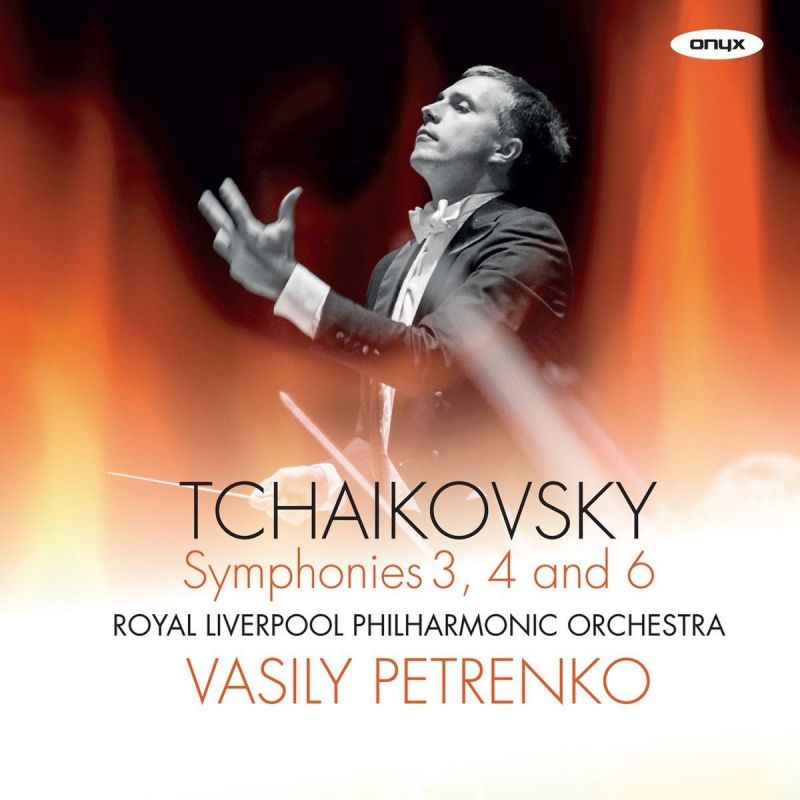TCHAIKOVSKY Symphonies Nos 3, 4 & 6
View record and artist detailsRecord and Artist Details
Composer or Director: Pyotr Ilyich Tchaikovsky
Genre:
Orchestral
Label: Onyx
Magazine Review Date: 03/2017
Media Format: CD or Download
Media Runtime: 118
Mastering:
DDD
Catalogue Number: ONYX4162

Tracks:
| Composition | Artist Credit |
|---|---|
| Symphony No. 4 |
Pyotr Ilyich Tchaikovsky, Composer
Pyotr Ilyich Tchaikovsky, Composer Royal Liverpool Philharmonic Orchestra Vasily Petrenko, Conductor |
| Symphony No. 3, 'Polish' |
Pyotr Ilyich Tchaikovsky, Composer
Pyotr Ilyich Tchaikovsky, Composer Royal Liverpool Philharmonic Orchestra Vasily Petrenko, Conductor |
| Symphony No. 6, 'Pathétique' |
Pyotr Ilyich Tchaikovsky, Composer
Pyotr Ilyich Tchaikovsky, Composer Royal Liverpool Philharmonic Orchestra Vasily Petrenko, Conductor |
Author: Mark Pullinger
It’s no surprise that Petrenko’s Fourth is a white-knuckle ride, speedy with dramatic hairpin dynamics. The Liverpool brass are imposing in the opening ‘Fate’ fanfare, although not quite as abrasive as Yevgeny Mravinsky’s Leningrad Phil, still the benchmark for the final three symphonies.
Petrenko bustles the movement along on waves of nervous anxiety and heart-on-sleeve emotion. The cantabile oboe in the second movement is beautifully sculpted but is always kept on the move. Petrenko leads a lightning fast pizzicato Scherzo – like dazzlingly executed pirouettes – interrupted by bucolic woodwinds. The finale bursts in and is helter-skelter fast, but never quite threatens to spiral out of control, whereas a frenzied Mravinsky teeters on the very brink.
Petrenko initially hurries into the Pathétique, although Semyon Bychkov finds more tension in his recent account, the Czech Philharmonic strings fretting more urgently in the passages reminiscent of Herman’s troubled mind in The Queen of Spades. Petrenko relaxes into the Andante section of the first movement (4'21"), just at the point where Bychkov sweeps forward – contrasting approcahes.
After the clarinet and bass clarinet – no bassoon for the final four quavers of that phrase – coil down to Tchaikovsky’s notorious pppppp marking, the power Petrenko unleashes in the Allegro vivo which follows (at 9'47") is startling.
The lopsided 5/4 Waltz is slightly breathless – in an invigorating way – and the bushy-tailed March packs a tremendous punch. Petrenko launches straight into the finale, which is neither as fevered as Mravinsky’s electrifying reading nor as fast as Bychkov’s recent rethinking. It’s movingly done, though, lower woodwinds and strings again impressing, brass building to a fine climax (8'09") before the steady decline and fade into oblivion.
The real joy in this set comes via the Third Symphony, dubiously nicknamed the Polish on account of its polacca finale. It’s the least performed of Tchaikovsky’s symphonies in concert. In fact, you’re more likely to encounter it at the ballet than in the concert hall, as most of it is used as part of the score to Balanchine’s Jewels (Diamonds) and MacMillan’s Anastasia, both of which form part of The Royal Ballet’s current season. It’s easily the most dance-like of the composer’s symphonies. Petrenko offers a coruscating reading, sparkling with imperial brilliance.
After a stately marcia funebre introduction, the accelerando into the Allegro brillante section (from 3'09") is full of anticipation, greeted by springy rhythms perfect for dancing. This really is Tchaikovsky-playing that bursts with sunshine, the strings imitating strummed balalaikas (7'25"). Petrenko makes Valery Gergiev’s LSO Live account sound sluggish, with an especially thrilling first-movement coda (from 12'50").
Like Schumann’s Rhenish Symphony, Tchaikovsky’s Third is in five movements, which means there are two faster ‘scherzo’-type inner movements. After the Third’s premiere, Tchaikovsky modestly wrote to Rimsky-Korsakov: ‘It seems to me that the Symphony does not present any particularly successful idea, but technically it’s a step forward. Above all I’m satisfied with the first movement and both scherzos, the second of which is very difficult.’ The Alla tedesca trips along daintily, carefree lines exchanged between flute and strings, while the RLPO woodwinds burble and ripple like a playful mountain stream in the jaunty Allegro vivo fourth movement. In between them, a lugubrious bassoon ponders in the Andante elegiaco, but Petrenko always keeps it fluid with a fine sense of the movement’s sweeping architecture. The RLPO strings aren’t as lush as their LSO counterparts but they sound quite glorious here. There is plenty of pomp in the finale, but Petrenko never allows the brass to bludgeon.
Vladimir Jurowski and the London Philharmonic are in the midst of an excellent survey on their own label, with just the Second and Third to come. However, with his excellent Manfred on Naxos thrown in as a supplement, I commend Petrenko’s as the finest modern cycle of Tchaikovsky’s symphonies currently available.
Discover the world's largest classical music catalogue with Presto Music.

Gramophone Digital Club
- Digital Edition
- Digital Archive
- Reviews Database
- Full website access
From £8.75 / month
Subscribe
Gramophone Full Club
- Print Edition
- Digital Edition
- Digital Archive
- Reviews Database
- Full website access
From £11.00 / month
Subscribe
If you are a library, university or other organisation that would be interested in an institutional subscription to Gramophone please click here for further information.




